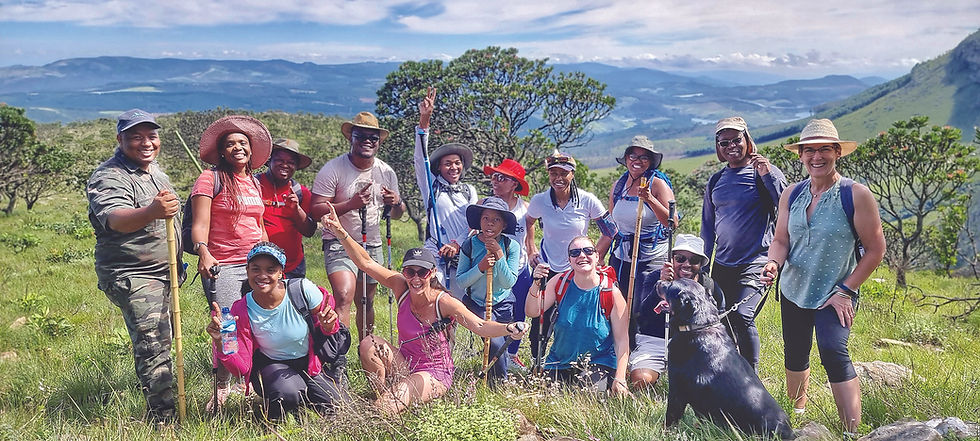WALK THE LOUIS CHANGUION TRAIL
- Bronwyn Egan
- Aug 28, 2023
- 3 min read
As people, we walk! Well, that’s what we used to do: walk to gather firewood, walk to find berries, walk to follow the promise of meat in a trail of sandy spoor. And we’d walk to visit one another. Six to sixteen kilometres a day, in all sorts of weather. Nowadays, however, people often ask: ‘Please take us walking!’ or, ‘When are we going to walk?’ or, ‘Where can we walk?’ It’s as if walking our 10 000 steps anywhere other than in our own homes is a specialised activity. Something needing training. Or a luxurious hobby, rather than an integral part of life.
We lost our foothold on the soil when we first set up shop. Released from walking to forage or hunt, to guide the plough or hoe the fields, we now suffer unintended consequences. As walking decreased, lower back pain increased. Standing upright and walking, centres our body weight so that we carry it in our feet. In contrast, sitting places all our upper body’s weight onto our coccyx, causing pain if we don’t move enough. More disturbingly, a lack of walking clogs up our cognitive abilities. As soon as we stand, look around, and mobilise our muscles into moving, we engage a multitude of neurons that stagnate if we sit all day. Walking strengthens brain areas engaged with memory and learning, and slows down detrimental changes occurring as our brains age. So why wouldn’t one walk?
Because where can one walk? Cities do not often provide green corridors, and walking willy-nilly into the bush is not always wise. Unlike retail outlets, trails are not well advertised. Knowing a local helps however, and in Haenertsburg, asking about trails will result in directions to the Louis Changuion Hiking Trail. Beautiful, wild and safe, this 10 km trail loops from the village of Haenertsburg, through endangered Woodbush Granite Grassland, into bush pockets, along river edges and back to the village.
The trail has its origins with local historian and hiker, Prof Louis Changuion, who, in the early ‘80’s was on the local committee of the Peri Urban Board in Pretoria, which managed the Haenertsburg area. On hearing that the board wished to put the grasslands around the village up for sale, for conversion to pine, the village members of the board objected. Even then, the intrinsic value of the grasslands around Haenertsbug was recognised by those who lived and walked in the area. The board, however, rejected the motion against conversion, insisting that the grassland ‘must be utilised!’ Clearly, carbon storage, water management, natural resource provision and sense of place were not considered valuable uses.
After the application to turn the grasslands into a nature reserve was rejected, Louis brought to the board’s attention a second suggestion: a walking trail. The board agreed, on condition that Louis develop the trail. After much time spent trail-planning, Louis left the village, only to return, months later, to discover that the trail had been named after him. Nipper’s Nook, Sally’s Slope and Jan’s Knoll, are resting places along the trail, celebrating community
input in cutting the path. Now maintained on a volunteer basis by Friends of the Haenertsburg Grassland, it showcases endangered aloes, wetland orchids, majestic forest trees and creatures.
Today the trail is used by dog walkers and trail runners, city escapees and medicinal plant collectors. It has seen nature lovers and students, reptile monitors and climate-change researchers. People from all walks of life leave the village in pristine hiking gear, to return, hours later, mud spattered, sun-blushed and dishevelled in body, but revitalised in spirit by toadstools and porcupines, chocolate bells and river music. Forty years ago, Louis Changuion, Mike Gardner, John Murray, Margaret Freestone and Theo Joubert, shared a vision and translated it into the trail that forms the backbone of the Haenertsburg Nature Reserve. Thanks to local dreamers and doers, we now have somewhere we can walk out into the wilderness and remember when the woods were wired into our brains and
the grasses embedded in our footprints.
So if you are in the Magoebaskloof area and want to follow your feet into the mountains for three, five or ten kilometres, depending on your preference, visit www.frohg.org for a map and more information.








Comments